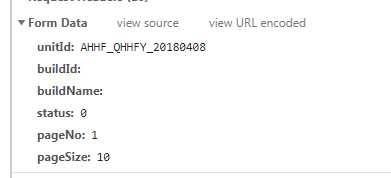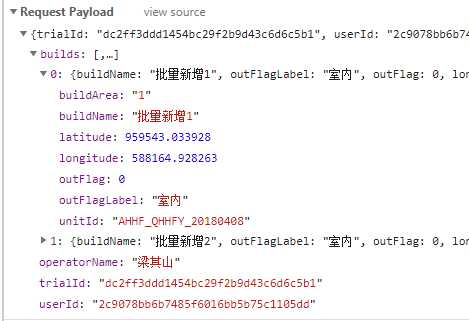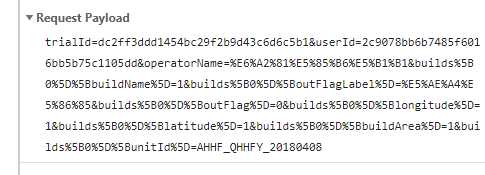一、前后端联调之Form Data与Request Payload
post方法之Form Data ‘Content-Type‘: ‘application/x-www-form-urlencoded; charset=UTF-8‘,
post(url, params, timeout) {
let token = Cookie.getJSON("auth") ? Cookie.getJSON("auth") : "";
let time = timeout ? timeout : 60000;
return axios({
method: ‘post‘,
url: url,
data: qs.stringify(params),
timeout: time,
contentType: false,
processData: false,
headers: {
‘X-Requested-With‘: ‘XMLHttpRequest‘,
‘Content-Type‘: ‘application/x-www-form-urlencoded; charset=UTF-8‘,
‘JSESSIONID‘: token.accessToken
}
}).then(
(response) => {
return checkStatus(response)
}
).catch(
(res) => {
return checkCode(res)
}
)
},
api.post("/enterpriseApi/toolBuild/getPageList", {
unitId: this.facilitiesInData.unitId,
buildId: this.buildId,
buildName: this.buildName,
status: this.status,
pageNo: this.widgetInfo.pageNo,
pageSize: this.widgetInfo.pageSize
}).then(res=>{})

postJson方法之Request Payload ‘Content-Type‘: ‘application/json; charset=UTF-8‘,
注意这里data: params里的params不能加qs.stringify(params),而直接是params,因为已经是json了,不需要再一次的序列号,否则就是最下面的情况。
postJson(url, params, timeout) {
let token = Cookie.getJSON("auth") ? Cookie.getJSON("auth") : "";
let time = timeout ? timeout : 60000;
return axios({
method: ‘post‘,
url: url,
data: params,
timeout: time,
contentType: false,
processData: false,
headers: {
‘X-Requested-With‘: ‘XMLHttpRequest‘,
‘Content-Type‘: ‘application/json; charset=UTF-8‘,
‘JSESSIONID‘: token.accessToken
}
}).then(
(response) => {
return checkStatus(response)
}
).catch(
(res) => {
return checkCode(res)
}
)
},
that.addDataObj.trialId = that.facilitiesInData.id;
that.addDataObj.userId = api.getGlobalVal(‘userObj‘).id;
that.addDataObj.operatorName = localStorage.getItem("userName");
that.addtableData.forEach((item)=>{
item.unitId = this.facilitiesInData.unitId;
})
that.addDataObj.builds = that.addtableData;
api.postJson("/enterpriseApi/toolBuild/addBatch", that.addDataObj)
.then(res=>{})

加qs.stringify(params):

原文:https://www.cnblogs.com/xiaoxiao529/p/13691096.html